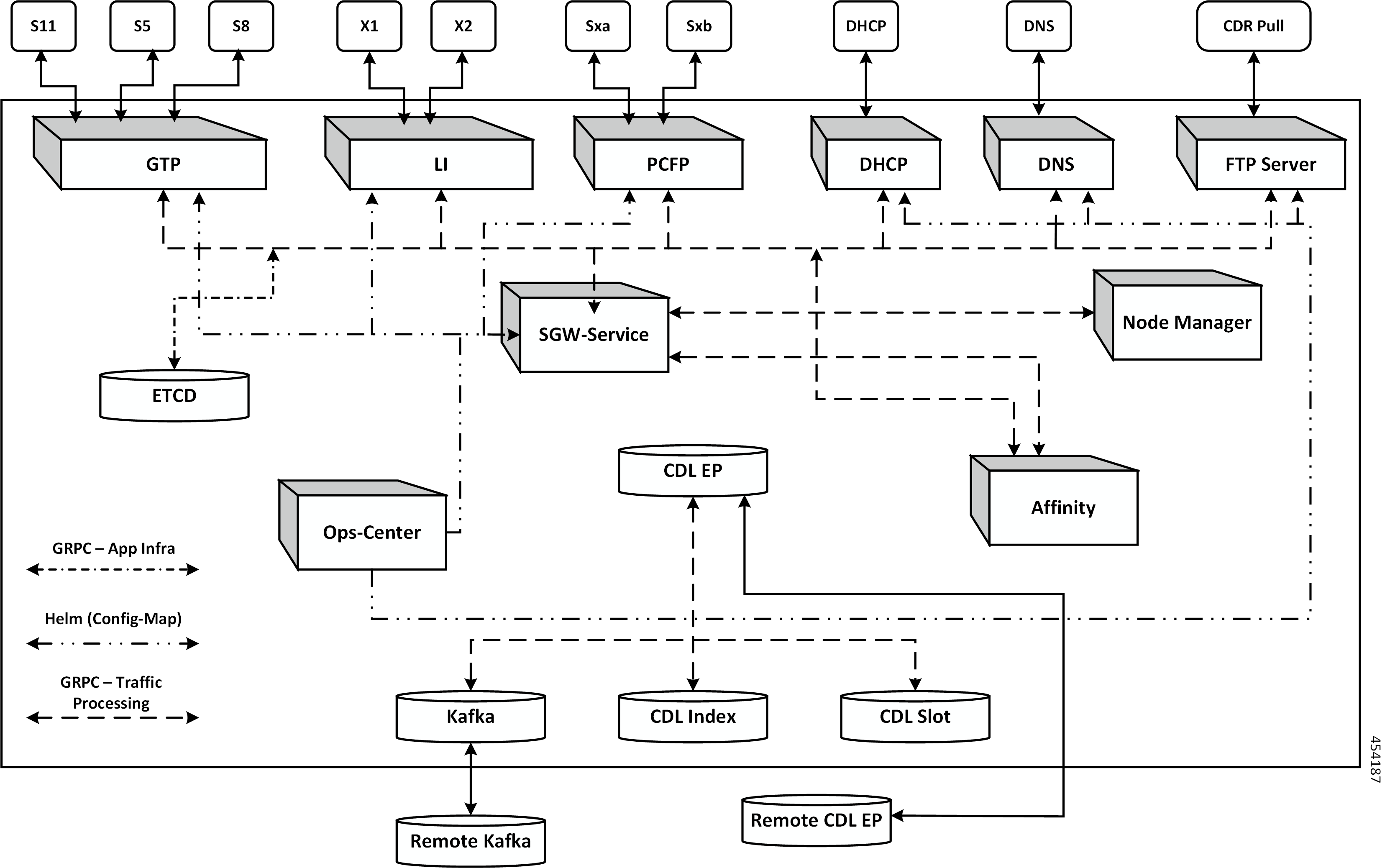-
cnSGW-C Configuration
The cnSGW-C base configuration provides a detailed view of configurations required for the cnSGW-C to be operational. The
configuration includes setting up the infrastructure to deploy the cnSGW-C, deploying the cnSGW-C through SMI, and configuring
the Ops Center for exploiting the cnSGW-C capabilities over time. For more information on SMI, see the Ultra Cloud Core SMI Cluster Deployer Operations Guide.
The following features are related to this use case:
For Converged Core deployment, cnSGW-C is deployed using Converged Ops Center.
-
Session Management
Every UE accessing the EPC is associated with a single S-GW. cnSGW-C supports multiple PDN for given UE. As a part of Session
Management, cnSGW-C supports the following:
The following features are related to this use case:
-
Support for UE Mobility
cnSGW-C is a mobility anchor point for UE. In LTE Network, there can be mobility between eNodeB to eNodeB, with or without
MME change. UE can also move from one cnSGW-C to another cnSGW-C with different modes, S1-based Relocation, X2-based Relocation,
and 5G-4G interworking.
The following features are related to this use case:
-
S1-Release/Buffering/Downlink Data Notification
cnSGW-C handles releasing S1-U bearer between eNodeB and SGW-U. When cnSGW-C receives Radio Access Bearers (RAB) message indicating
that S1-U bearers are released, it updates User Plane and moves UE to IDLE state. When in IDLE state, if UE receives downlink
data packet, cnSGW-C generates DDN message towards MME to page UE.
cnSGW-C also supports DDN Throttling, DDN Delay, and High Priority feature for DDN.
The following features are related to this use case:
-
Retransmission and Timeout
For all procedures, as per 3GPP TS 23.401/29.274, cnSGW-C supports N3-Retransmission, and T3-Timeout Support. These are supported for S11, S5, and Sx interfaces.
The following feature is related to this use case:
-
Failure and Error Handling
cnSGW-C supports handling of:
-
Failure response for Create Session Request as part of initial attach procedure and additional PDN setup procedure
-
PGW-initiated Dedicated Bearer Creation (DBC) procedure failure scenario
-
Radio Access Bearers (RAB), Modify Bearer Request and Response (MBR) from PGW and User Plane
The following feature is related to this use case:
-
Load/overload Control Functions
cnSGW-C supports:
The following features are related to this use case:
-
cnSGW-C Charging Support
cnSGW-C supports:
-
Offline Charging (Gz).
-
Writing CDR to local disk storage. The CDR files are pushed to SFTP server periodically.
-
CDR generation for selected subscribers. This is achieved by enabling CDR generation per Operator Policy through call control
profile.
The following feature is related to this use case:
-
Peer and Path Management for GTPC and Sx
cnSGW-C supports:
-
Peer management for MME (S11 peers), PGW (S5 Peers), and User Plane.
-
Peer monitoring through ECHO Request/Response and Heartbeat Request/Response.
-
Handling of path failure events for S11 and S5 peers.
The following features are related to this use case:
-
Redundancy Support
The cnSGW-C deployment in K8 cluster plays a vital role to support High Availability (HA) and Geographic Redundancy (GR).
The Redundancy Support ensures stateful session continuity among the clusters during the rack or cluster failures.
The cnSGW-C achieves the HA through redundant set-up of each cluster component such that any single point of failure is avoided.
The GR provides rack-level redundancy to replicate data between two separate K8 Clusters across rack. On RACK/Cluster failure,
traffic switches to a remote RACK to process the traffic. The failure can be due to power failure, multi-compute failures,
network failure, multi-POD failure, BFD link failure, and so on.
The following features are related to this use case:
-
Dynamic Routing
Dynamic routing enables L3 peering with Leafs, in addition to L2 Static routing.
The following feature is related to this use case:
-
GTPU Path Management and Session Management
The UPF notifies an Error Indication message for a GTP-U peer to the sender when a GTP-PDU is received with a TEID that does
not exist. This ensures that there are no stale sessions or bearers, and maintains consistency in the network.
Error Indication and GTP-U Path Failure Indication communication between S-GW and UPF nodes is supported over the N4 interface.
For the neighbor nodes, the communication is supported over the S1u/S5u interfaces. Behavior variations of local-purge or
signal-peer for Error Indication and GTP-U Path Failure are considered in this implementation.
The following features are related to this use case:






 Feedback
Feedback